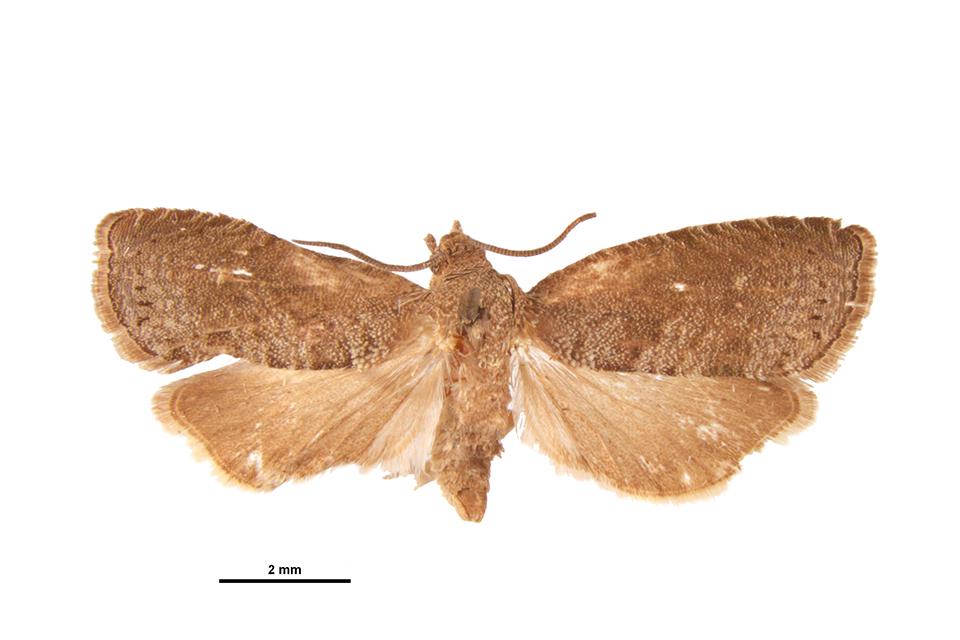Oriental Fruit Moth Lands In Hot Water — And It’s a Good Thing

Up-close view of an adult Oriental fruit moth.
Photo courtesy of Pest and Diseases Image Library , Bugwood.org
Justin Renkema wants to eliminate oriental fruit moth (OFM) in young apple trees. But the Canadian Research Entomologist never wants to throw the baby out with the bath water just because the water was too hot. “I think you can probably kill insects or mites at almost any [water] temperature,” Renkema says. “It’s just going to be: How does the plant react to that?”
Representing Agriculture and Agri-Food Canada, that country’s counterpart to USDA, Renkema headlined a webinar on physical control methods for eliminating pests on planting material. Presented by the New York State Integrated Pest Management Program, the discussion was split between using transplant steam treatment to improve cyclamen mite management in strawberry and using hot water treatments to eradicate OFM on fruit tree nursery stock.
Physical control involves the modification of the physical environment to obtain a required level of control. Physical environment is any abiotic variable, such as temperature, humidity, light, and soil, that may affect the target pest.
“I thought I would go back to some of my IPM texts that I have here in the office and see what exactly the texts define physical control as,” Renkema says. “Interestingly, that term is not even in a lot of IPM texts, and if it is, it’s usually a fairly short section. We know of some of the big options for control, such as chemical control, biocontrol, and genetic control, but sometimes physical control is not one of the main ones we think about in an IPM program. But it can be a very important way to control pests in certain habitats or environments.”
High temperatures are known to cause insect or mite death. But the “big but,” Renkema adds, is that they may also negatively affect the planting material that the pests are on.
Methyl Bromide Alternative
Renkema’s OFM research stems from the fact that OFM is classified as a quarantine pest in Canada. To prevent the introduction of the moth into British Columbia (B.C.), the Canadian Food Inspection Agency presently mandates that hosts and carriers of OFM arriving from infested areas of Canada, the U.S., and other countries require fumigation before they may be shipped into B.C.
However, methyl bromide, while effective, is being phased out because of its ozone-depleting properties. To currently use it requires permits, which is a difficult and expensive process, Renkema says.
“If a nursery wants to sell trees into B.C., they have to be oriental fruit moth-free,” Renkema says. “So, the research is really motivated by collaborators in British Columbia who are looking for a methyl bromide alternative to control OFM on fruit trees.”
One such alternative is hot water dips of trees. The treatment has succeeded as a control for codling moth — a close relative to OFM — in sweet cherries and apples. Hot water has also controlled pathogens in grapes, mealybugs on grape cuttings, and scales and aphids on flowering plants.
“And compared to methyl bromide, hot water is relatively safe, cheap, and easy to use,” Renkema says.
FINDING THE RIGHT MIX
What combination of hot water temperature and time allotment is lethal to diapausing OFM pupae while not reducing fruit tree survival and growth?
Two laboratory experiments conducted by Renkema and then-Brock University Master’s student Franklin Dubon involved temperatures of 45°C and 47°C applied over periods between 15 and 60 minutes. In the first experiment, no combination resulted in 100% mortality rate with diapausing cocoons. But in the second experiment, longer periods of 47°C — 35 to 45 minutes — achieved complete mortality.
Moved to the field in 2021, the experimenting involved one-year-old ‘Ambrosia’ apples on M9 rootstock. Diapausing OFM cocoons in cardboard were wrapped around the trees, which were hot water-treated, in large tubs and then returned to cold storage for three weeks before being planted in mid-May.
Six replicates included temperatures between 24°C and 50°C, the latter of which was applied for only five minutes.
“We included treatment six because we had done some initial testing just before the field season and read some new things in the literature that a higher temperature for a shorter duration may be quite effective for OFM,” Renkema says.
As expected, he notes, 100% mortality was achieved with two treatments: 47°C for 35 minutes and 50°C for five minutes.
However, the 47°C/35-minute treatment resulted in nearly 60% unopened buds. The other three hot water treatments were slightly higher than the two controls but nowhere near the 60% of 47°C. Likewise, in terms of total fresh weight of new growth, the results were not significantly different among the treatments except, again, with 47°C/35 minutes. No significant differences were observed in root weight and trunk diameter.
Testing then returned to the lab with a focus on 50°C treatments between 1 minute and 5 minutes. “Our question was: For how short of a duration at 50°C could we go and still get 100% moth mortality?” Renkema says. “The answer is three minutes. If we did it for three minutes, we got 100%. At two minutes we’re down to 70% or so.”
Back to the field in 2022, using ‘Honeycrisp’ as well as ‘Ambrosia’, 50°C was evaluated at 2 minutes 55 seconds and five minutes. Surprisingly, neither treatment resulted in 100% OFM mortality, although there were significantly fewer OFM on trees treated at 50°C (about half an adult OFM on average at five minutes and closer to six at nearly three minutes).
“This is not what we expected and not what we were hoping for,” Renkema says. “In terms of why … it’s probably because we were just a little bit below 50°C when these trees were treated.”










